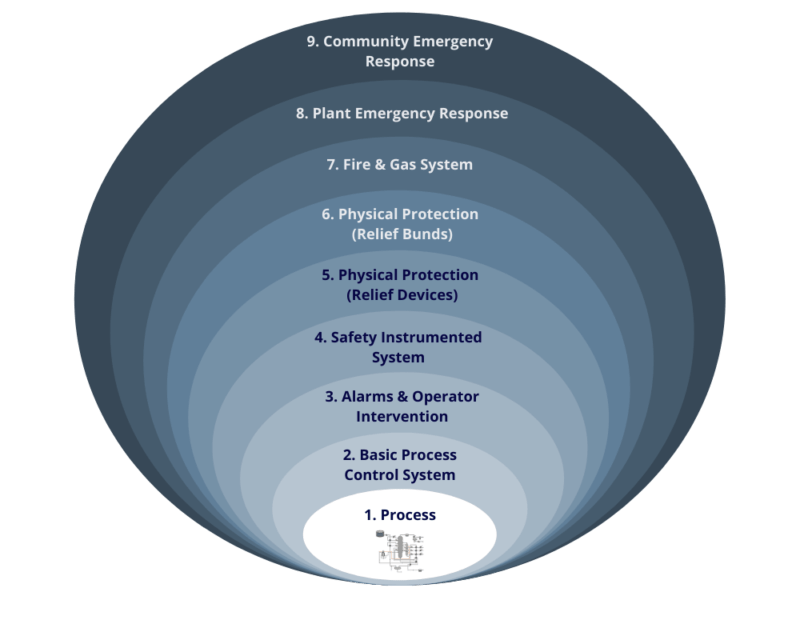Risk Assessement
Risk assessments are the first and most important step on your functional safety journey. Risk assessments help you identify risks, determine if existing measures are adequate and identify risk reduction mechanisms. In Process Safety, the risk receptors are usually staff, the general public, business loss, reputation and the environment. Using international standards, including IEC 61511 and IEC 61508, NeoDyne’s team of functional safety engineers have the experience and expertise to help you identify gaps in your Safety Instrumented System (SIS) and make well-informed decisions on risk management strategies. We use both quantitative and semi-quantitative risk assessment techniques, including:
- Hazard and Operability (HAZOP) study
- Process Hazard Assessment (PHA)
- Layer Of Protection Analysis (LOPA)
- Bow Tie Analysis
- Integrated Manufacturing System (IMS) Risk Assessment
- Failure Modes and Effects Analysis (FMEA)
- Quantitative Risk Assessment (QRA)
We employ cutting-edge methodologies, including Fault tree driven Markov models and RBD driven petri nets, and leverage our broad and deep industry knowledge to ensure all risks are appropriately identified and assessed.
The primary output of the Risk Assessment phase is the Safety Requirements Specification (SRS). The SRS incorporates all the necessary outputs from the HAZOP/ PHA and LOPA studies and defines the SIS requirements. Safety design is based on the SRS.
Hazard and Operability (HAZOP) / Process Hazard Assessment (PHA)
A HAZOP study is a structured and systematic examination to identify potential hazards in industrial processes, including risk to personnel, equipment and the environment. HAZOP is a powerful communication tool, using a brainstorming approach to risk assessment with qualitative and inductive (bottom-up) assessment tools. A HAZOP is completed over four distinct phases, namely: Definition, Preparation, Examination and Documentation & Follow-up.
Definition
Definition
2. Define responsibilities
3. Select Team
Preparation
Preparation
2. Agree on guide words and style of recording
3. Estimate the workshop effort and agree meeting schedule
Examination
Examination
2. Identify protection, detection, and indicating mechanisms
3. Agree possible remedial/safeguarding measures and actions
Documentation & Follow-up
Documentation & Follow-up
2. Document all follow-up actions in an actions register
3. Sign off on the HAZOP study
Layer Of Protection Analysis (LOPA)
LOPA is a method used to risk assess high-consequence scenarios to evaluate the adequacy of protection layers. It determines whether the probability of occurrence and severity of consequences meets a company’s risk tolerance. LOPA is widely used for establishing safety instrumented system needs in the process industry.
Our approach involves:
- Identifying process safety hazards from a HAZOP/ PHA, customer documentation or other study
- Identifying causes and consequences of potential hazards
- Identifying and estimating the frequency of initiating events
- Identifying the independent protection layers that are available and estimating the probability of failure of each layer
- Identifying safeguards to guard against the hazard and calculating the mitigated consequence frequency
- Determining the resulting safety integrity level (SIL) where a safety instrumented function (SIF) is required

Layers of Protection – Process Related Hazards
Bow Tie Analysis
Bow Tie analysis illustrates the relationships between hazards, potential consequences, barriers, degradation factors and controls. Shaped like a bow-tie, it creates a clear differentiation between proactive and reactive risk management. It enables the identification and prioritisation of actions to strengthen and maintain risk controls in the safety management system. It is a methodology that’s becoming popular, particularly where there is a high level of risk or where control effectiveness is low. It is also easily interpreted by non-technical users.
Integrated Manufacturing System (IMS)
Risk Assessments for an IMS, such as assembly machines (packaging, palletising and wrapping) are highly complex and require multiple layers of expertise and knowledge. We use ISO 11161 to complete our risk assessments, which provides the requirements and recommendations for the IMS’s safe design, safeguarding, and operational best practice. The risk assessment process follows ISO 12100, paying particular attention to the interfaces between the different parts of the IMS and associated hazards.
Failure Modes and Effects Analysis (FMEA)
FMEA is a methodology to systematically identify faults and failures and their causes. The methodology uses a “bottom-up” approach and is cause-oriented. It focuses on examining individual faults and failures and is typically used in Machine Safety risk assessments.
Quantitative Risk Assessment (QRA)
QRA is a formal and systematic approach for identifying hazardous events and estimating the likelihood and impact of same. The method allows for quantitative risk estimation based on the potential for safety, environmental or financial impact.
Driving technology for leading brands
Integration & Digital Manufacturing Customers
We supply the Life Science, Food & Beverage, Data Centre and Energy industries.
Our key markets are for robust applications requiring innovation, reliability, longevity and specialised know-how.

















